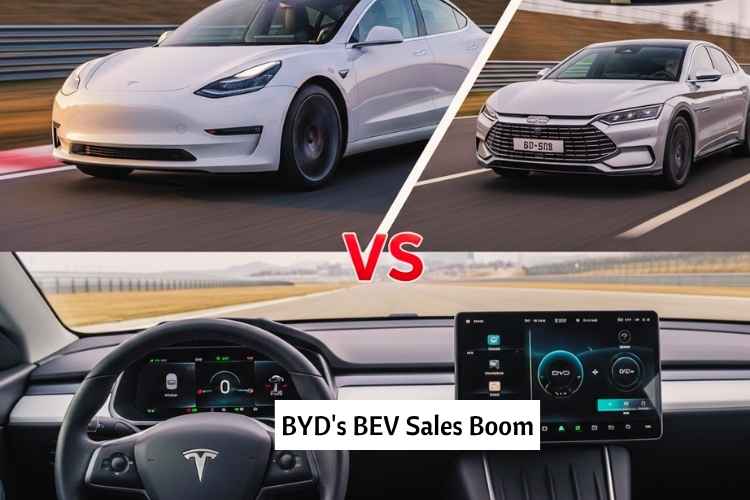BYD BEV Sales Boom: In 2025, the EV landscape is heating up. Tesla, the industry pioneer, is facing a potential loss of tax credits under shifting U.S. policies, risking a decline in buyer incentives. Meanwhile, Chinese giant BYD is surging, with BEV sales skyrocketing and poised to overtake Tesla. Our in-depth analysis delves into the full story.

Table of Contents
BYD BEV Sales Boom: Tesla vs BYD – 2025 Overview
| Category | Tesla | BYD |
|---|---|---|
| 2024 BEV Sales | ~1.79 M | ~1.76 M; includes hybrids total ~4.27 M |
| Q1 2025 BEV Sales | ~336 k (–13% YoY) | ~416 k (+39% YoY); total NEV ~990 k (+59%) |
| Tax Credit Impact Tesla | Potential sunset Sept 2025, deliveries down 13–20% | |
| Tax Credit Impact Consumers | Tax Credit Impact on Tesla | Benefit from internal subsidies & scale |
| Market Share Outlook | Expected ~ 15% | Q1 BEV grew 18% as buyers rushed for credit |
BYD’s Explosive Growth & BEV Domination
- Quantitative Surge
BYD shipped ~416k BEVs in Q1 2025 (+39% YoY), outpacing Tesla’s 336k by ~80k units. - Scale Advantage
Total NEV sales soared ~990k (+59%), driven by both BEV and PHEV models. - Global Positioning
Analysts from Counterpoint forecast BYD to lead the BEV market share in 2025 (~15.7%). Current growth sets BYD on track to overtake Tesla. - Supporting Infrastructure
China’s subsidies, BYD’s vertically integrated supply chain (especially its Blade battery), and ultra-fast charging systems give it a cost edge.
Conclusion on BYD BEV Sales Boom
- Tesla’s Key Challenges: Tax credit risk, slowing deliveries, regulatory struggle, and brand headwinds.
- BYD’s Strengths: Massive sales growth, tech control, price competitiveness, and global scale.
- Market Outlook: If trends hold, 2025 becomes the year BYD overtakes Tesla in BEV volume and possibly market sentiment.
What Tesla must do next:
- Push out affordable models with a good range.
- Deliver on the FSD/robotaxi promise.
- Protect margins even as it competes against low-cost rivals.
What BYD should watch:
- U.S. and EU tariff and regulatory shifts.
- Brand establishment outside China.
- Product differentiation, e.g., more luxury/tech offerings.
Bhakti Rawat is a Founder & Writer of InsureMyCar360.com. This site Provides You with Information Related To the Best Auto Insurance Updates & comparisons. 🔗
